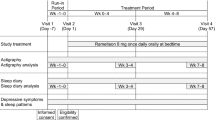Abstract
Quetiapine is frequently prescribed for insomnia that is comorbid with psychiatric disorders, but there has been no documentation of metabolic adverse effects associated with this practice. The objective of this study was to document changes in weight, body mass index, and waist circumference that occurred when low-dose quetiapine was used at bedtime for insomnia. The study was a retrospective chart review conducted at a community mental health center. Patients were non-elderly (19–65 years old) psychiatric patients who received quetiapine at ≤200 mg at bedtime for the explicit indication of insomnia. Forty-three patients were included in the study. Weight and BMI increased by an average of 4.9 lb. (P = 0.037) and 0.8 points (P = 0.048), respectively. Males experienced statistically significant increases in weight and BMI, and Caucasians experienced a statistically significant increase in BMI. There were no significant differences between baseline and endpoint metabolic parameters when examined by baseline BMI, age category, psychiatric diagnosis, or concomitant psychotropic medication. Despite the low doses typically used when quetiapine is prescribed for insomnia, metabolic adverse effects can occur and should be considered in the overall benefit to risk analysis.
Similar content being viewed by others
References
Adityanjee, S. S. C., & Schulz, S. C. (2002). Clinical use of quetiapine in disease states other than schizophrenia. The Journal of Clinical Psychiatry, 63(suppl 13), 32–38.
Aichhorn, W., Whitworth, A. B., Weiss, E. M., & Marksteiner, J. (2006). Second generation antipsychotics: Is there evidence for sex differences in pharmacokinetic and adverse effect profiles? Drug Safety, 29(7), 587–598. doi:10.2165/00002018-200629070-00004.
Becker, P. M. (2006). Treatment of sleep dysfunction and psychiatric disorders. Current Treatment Options in Neurology, 8(5), 367–375. doi:10.1007/s11940-006-0026-6.
Bhat, A., Shafi, F., & Solh, A. A. E. (2008). Pharmacotherapy of insomnia. Expert Opinion on Pharmacotherapy, 9(3), 351–362. doi:10.1517/14656566.9.3.351.
Brecher, M., Leong, R. W., Stening, G., Osterling-Koskinen, L., & Jones, A. M. (2007). Quetiapine and long-term weight change: A comprehensive data review of patients with schizophrenia. The Journal of Clinical Psychiatry, 68(4), 597–603.
Cohrs, S., Rodenbeck, A., Guan, Z., Pohlmann, K., Jordan, W., Meier, A., et al. (2004). Sleep-promoting properties of quetiapine in healthy subjects. Psychopharmacology, 174(3), 421–429.
Consensus Development Conference on Antipsychotic Drugs and Obesity and Diabetes. (2004). Diabetes Care, 27(2), 596–601.
Newcomer, J. W. (2005). Second-generation (atypical) antipsychotics and metabolic effects: A comprehensive literature review. CNS Drugs, 19(suppl 1), 1–93. doi:10.2165/00023210-200519001-00001.
Passarella, S., & Duong, M. T. (2008). Diagnosis and treatment of insomnia. American Journal of Health-System Pharmacy, 65(10), 927–934. doi:10.2146/ajhp060640.
Philip, N. S., Mello, K., Carpenter, L. L., Tyrka, A. R., & Price, L. H. (2008). Patterns of quetiapine use in psychiatric inpatients: An examination of off-label use. Annals of Clinical Psychiatry, 20(1), 15–20. doi:10.1080/10401230701866870.
Todder, D., Caliskan, S., & Baune, B. T. (2006). Night locomotor activity and quality of sleep in quetiapine-treated patients with depression. Journal of Clinical Psychopharmacology, 26(6), 638–642. doi:10.1097/01.jcp.0000239798.59943.77.
Wiegand, M. H., Landry, F., Brückner, T., Pohl, C., Veselý, Z., & Jahn, T. (2008). Quetiapine in primary insomnia: A pilot study. Psychopharmacology, 196(2), 337–338. doi:10.1007/s00213-007-0968-8.
Author information
Authors and Affiliations
Corresponding author
Rights and permissions
About this article
Cite this article
Cates, M.E., Jackson, C.W., Feldman, J.M. et al. Metabolic Consequences of Using Low-Dose Quetiapine for Insomnia in Psychiatric Patients. Community Ment Health J 45, 251–254 (2009). https://doi.org/10.1007/s10597-009-9200-0
Received:
Accepted:
Published:
Issue Date:
DOI: https://doi.org/10.1007/s10597-009-9200-0




